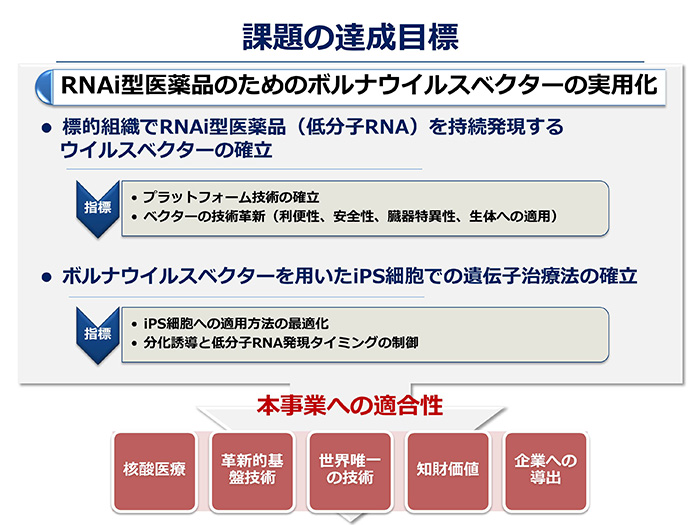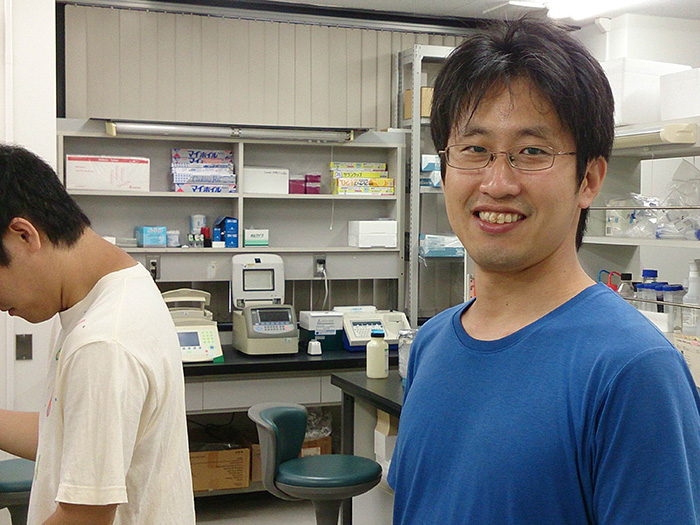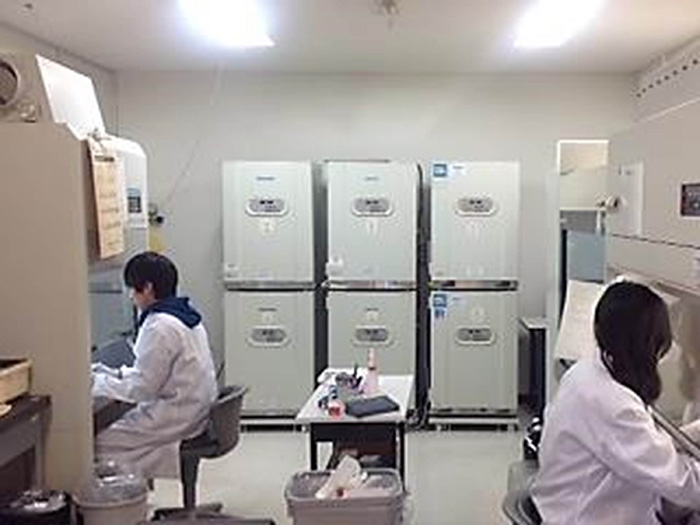Research and Development Projects Adopted in FY2014
Development of an RNA virus vector system that stably expresses RNAi drug in target tissues and pluripotent stem cells
Project Leader:Tomonaga Keizo
Professor, Institute for Virus Research, Kyoto University
The clinical development of RNA interference (RNAi) technology, the gene silencing method that could control disease-related gene expressions, has been highly competitive in industrialized countries.
However, because there are some technical difficulties in the efficient local delivery and the long-term stable expression of small RNA molecules, clinical application of RNAi therapies has not yet progressed for the last decade.
Our long-term goal is to develop the breakthrough technology that resolves the existing problems on the clinical application of RNAi therapies and that enables to deliver therapeutic RNA molecules to the right cells at the right time.
Bornavirus, animal-derived RNA virus, has a unique property in that it persistently infects in the nucleus of various-type of cells.
This characteristic allows this virus to serve as a new platform of small RNA expression vector system. We have succeeded to the long-term stable transduction of foreign gene into various organs, including the cells of the central nerve system.
Furthermore, we have shown that bornavirus vector could transduce foreign gene in iPS cells and mesenchymal stem cells, and the vector transduction does not affect the differentiation capacity of modified stem cells.
We are aiming the establishment of bornavirus vector for RNAi-type clinical application, based on six important pillars of study plan as stated below.
- Development of platform of bornavirus vector that can achieve long-term stable transduction of functional small RNA in cells.
- Technical innovation of the bornavirus vector production
- Attenuation of the bornavirus cytotoxicity and minimizing side effects.
- Establishment of stable transduction system for small RNA in target organs in vivo
- Transduction of iPS cells by bornavirus vector without affecting their pluripotency
- Development of on/off switching system for the transduction of small RNA from bornavirus vector
The striking characteristics of this study are the development of small RNA transduction technology using bornavirus, a unique RNA virus.
Our research has been world-leading and the scientific technologies and insights applied for this study plan are our original achievements.
This study will dramatically improve the previous bornavirus study and the development of its vector.
This study will achieve a breakthrough of the clinical application of RNAi in vitro and in vivo, and will provide a new therapeutic technology for the treatment of refractory diseases,
such as neurodegenerative diseases and cancers. Since bornavirus vector can be available for stem cell modifications, our system will also contribute to the regenerative therapy and aging medicine in future.
<Figure1>Goal of this research
Our goal is to develop the elemental technologies that resolve the existing problems on the clinical application of small RNAs and that enable to deliver RNAi-based drugs and to express the RNAi into the target organs.
The achievement of this research will be evaluated by the milestones as indicated below; development of platform of Borna disease virus vector,
technical innovation of the vector production, the optimization of the application method to the iPS cells, and establishment of ON/OFF switching system for the transduction of small RNA.
<Figure2>Molecular biology laboratory
Our research is performed in this laboratory, which has equipment for almost every basic molecular biological experiment.
<Figure3>P2 laboratory
The recombinant viruses for this research are handled in P2 laboratory with biological safety cabinets.



